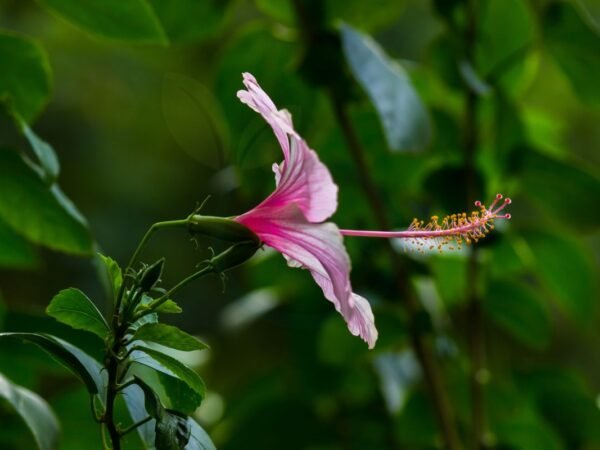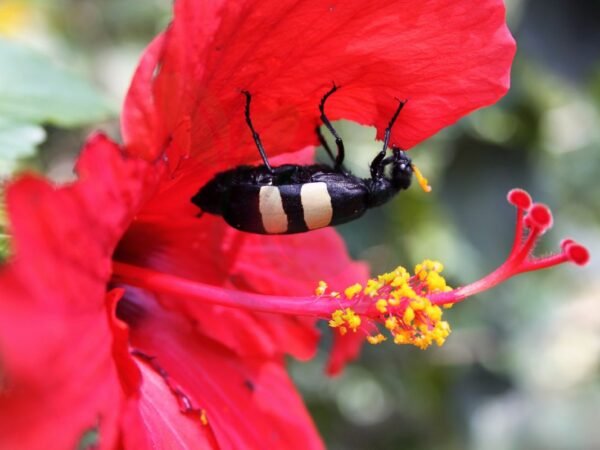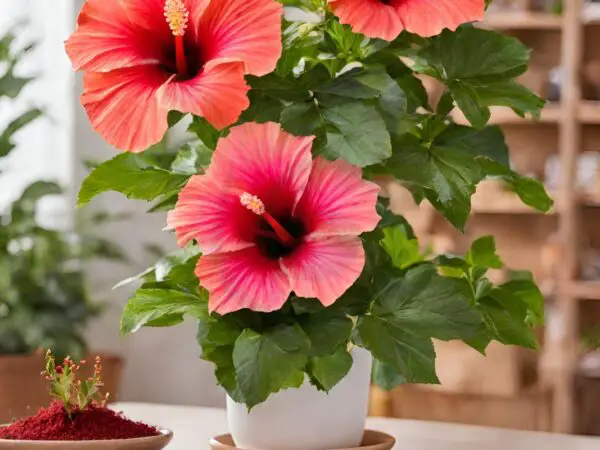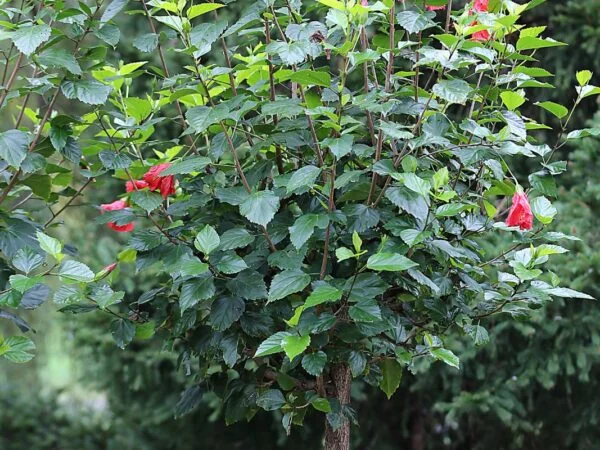Wondering when is the best time to plant hibiscus seeds? We've got you covered with expert tips and guidance to ensure your hibiscus garden thrives. Planting hibiscus seeds at the optimal time is crucial for successful growth and vibrant blooms.
Curious about the ideal planting season for hibiscus seeds? Stay tuned as we delve into the historical context, best practices, essential steps, sowing, and ground to maximize your gardening success. Get ready to unlock the secrets to a flourishing hibiscus garden!
Key Takeaways
-
Plant hibiscus seeds in the spring after the last frost for optimal growth.
-
Start seeds indoors to control growing conditions and ensure successful germination.
-
Transplant seedlings carefully to prevent root damage and encourage healthy growth.
-
Provide proper care to young plants by watering consistently and fertilizing appropriately.
-
To encourage blooming, place hibiscus plants in a sunny location and prune them regularly.
-
Address common challenges like pests and diseases promptly to maintain plant health.
Understanding Hibiscus Seeds
Seed Varieties
Hibiscus seeds come in various varieties, including single and double blooms. Single bloom hibiscus seeds produce flowers with a single layer of petals, while double bloom varieties have multiple layers. Each variety offers unique colors and patterns, adding diversity to your garden.
-
Single bloom hibiscus seeds are known for their simplicity and elegance.
-
Double bloom hibiscus seeds create lush, full flowers that are visually striking.
-
Different hibiscus seed types thrive in specific conditions; for example, some may prefer more sunlight while others require partial shade.
Growth Potential
When planting hibiscus seeds, you can expect vigorous growth leading to beautiful blooms. The growth potential of hibiscus plants is influenced by factors such as sunlight, water, soil quality, and temperature.
-
Hibiscus plants can grow up to 6 feet tall depending on the variety.
-
Proper care and maintenance can encourage healthy growth and abundant flowering.
-
Hibiscus plants go through stages of development from seedling to mature plant, each stage marked by distinct characteristics.
Germination Basics
The germination process of hibiscus seeds involves several key steps that are essential for successful growth. To ensure optimal germination rates, provide warmth, moisture, and proper soil conditions for the seeds.
-
Hibiscus seeds require a warm environment to sprout effectively.
-
Adequate moisture levels are crucial during the germination period.
-
Enhancing germination rates can be achieved by soaking the seeds overnight before planting them.
Optimal Planting Time
Seasonal Guide
Plant hibiscus seeds in the spring for optimal growth. The warmer temperatures and longer days promote seed germination. In summer, make sure to water the seeds regularly to maintain moisture levels. During fall, protect young plants from cooler temperatures by moving them indoors.
Seasonal variations significantly impact hibiscus seed planting. Spring and summer provide the best conditions for seeds to sprout and grow. Fall can be challenging due to temperature drops, requiring extra care for plant protection.
-
Spring: Ideal for hibiscus seed planting due to warm weather.
-
Summer: Ensure consistent watering for healthy seedlings.
-
Fall: Protect plants from cold weather by bringing them indoors.
Climate Considerations
Climate plays a crucial role in successful hibiscus seed planting. Warmer climates are ideal for year-round growth, while colder climates may require indoor cultivation or greenhouse settings. Adjust watering schedules based on humidity levels.
Different climates affect hibiscus seed growth differently. Hot climates may necessitate more frequent watering to prevent drying out, while cooler climates may need less water to avoid root rot.
-
Warm Climates: Regular watering is essential to prevent dehydration.
-
Cold Climates: Consider indoor cultivation or greenhouses for protection.
Regional Differences
Regional variations influence hibiscus seed planting success rates. Coastal regions with milder temperatures are favorable for outdoor planting, while inland areas with extreme temperatures might require controlled environments like conservatories or heated spaces.
Geographical locations play a significant role in determining hibiscus seed growth outcomes. Coastal areas benefit from moderate temperatures that support outdoor planting in the garden, whereas inland regions with harsher climates may need additional protection measures.
-
Coastal Regions: Optimal conditions for outdoor hibiscus planting.
-
Inland Areas: Consider controlled environments for better growth results.
Preparing for Planting
Soil Preparation
l preparation is crucial for successful hibiscus seed planting as it directly impacts germination. The soil should be well-draining, rich in nutrients, and slightly acidic. To achieve this, mix organic matter like compost into the soil to improve its quality. Ensure the soil is loose to allow for proper root growth.
For hibiscus seeds to germinate effectively, the ideal soil conditions include being well-drained to prevent waterlogging, aerated for oxygen circulation, and rich in nutrients for healthy growth. Avoid compacted or clayey soils that hinder root development. A pH level between 6.0 and 7.0 is optimal for hibiscus seed germination.
To prepare the soil for hibiscus seeds, start by clearing the area of any debris or weeds. Loosen the soil using a garden fork or tiller to a depth of about 12 inches. Mix in organic matter such as compost or peat moss to enrich the soil with nutrients. Finally, level the ground before planting the hibiscus seeds.
Location Selection
Selecting the right location is key when planting hibiscus seeds to ensure optimal growth and blooming. Choose a spot that receives full sunlight for at least six hours a day and has protection from strong winds. Consider planting near a south-facing wall for added warmth.
Factors to consider when selecting a planting spot include sunlight exposure, wind protection, and proximity to other plants that may compete for resources. Avoid areas with poor drainage or where water tends to accumulate as this can lead to root rot in hibiscus plants.
To optimize hibiscus seed growth in the garden based on location, consider using mulch around the base of the plant to retain moisture and regulate soil temperature. Ensure there is enough space between plants for proper air circulation and avoid overcrowding.
Watering Needs
Hibiscus seeds require consistent moisture levels for successful germination and growth. Water newly planted seeds gently but deeply to reach the root ball without causing waterlogging. Maintain moist but not waterlogged soil throughout the growing season.
When watering hibiscus seedlings, aim for consistency by providing water whenever the top inch of soil feels dry to the touch. Adjust watering frequency based on weather conditions; during hot periods, more frequent watering may be necessary to prevent dehydration.
To maintain optimal soil moisture levels, consider using a soaker hose or drip irrigation system to deliver water directly to the roots without wetting the foliage excessively. Mulching around the plants can also help retain moisture in the soil.
Starting Seeds Indoors
Proper sowing techniques are crucial for successful hibiscus seed germination. Ensure that the seeds are not buried too deep in the soil to allow for adequate air circulation. Lightly press the seeds into the soil and cover them with a thin layer of moist soil.
To promote healthy seedling growth, maintain consistent moisture levels in the soil. Avoid overwatering, which can lead to rotting, and ensure that the soil is well-draining. Place the planted seeds in a warm location with indirect sunlight to encourage germination.
-
Plant hibiscus seeds shallowly
-
Maintain consistent moisture levels
-
Provide indirect sunlight for optimal growth
Hibiscus seeds require ample light for successful germination and growth. Place the planted seeds in a location where they receive bright, indirect sunlight for at least six hours per day. Insufficient light can result in weak seedlings with poor growth.
Light exposure plays a vital role in photosynthesis, which is essential for plant development. Without adequate light, hibiscus seedlings may become leggy and struggle to produce energy through photosynthesis. Consider using grow lights if natural light is limited.
-
Ensure 6+ hours of indirect sunlight daily
-
Light influences photosynthesis and growth
-
Supplement with grow lights if necessary
Maintaining proper temperatures is key to successful hibiscus seed planting. Keep the planted seeds in an environment with temperatures consistently between 70-80 degrees Fahrenheit. Fluctuating temperatures can hinder germination and slow down seedling growth.
The optimal temperature range ensures that the seeds remain warm enough to sprout without being exposed to extremes that could damage them. To regulate temperatures effectively, consider using a heat mat or placing the seeds near a heat source like a radiator.
-
Maintain temperatures between 70-80°F
-
Consistent temperatures support germination
-
Use heat mats or heat sources for regulation
Transplanting Seedlings
Hardening Off Process
Transplant hibiscus seedlings by gradually exposing them to outdoor conditions. Start by placing them in a sheltered spot outside for a few hours daily. Increase exposure over 7-10 days. This process toughens the plants, preparing them for permanent planting.
Gradually acclimating seedlings to outdoor conditions is crucial. It helps prevent shock and stress, increasing their chances of survival. Hardening off reduces transplant shock and ensures better growth post-transplantation.
To successfully harden off hibiscus plants, begin the process after the last frost date in your area. Start by moving seedlings outdoors during mild weather periods. Increase exposure gradually, starting with a few hours per day and extending it over time.
Ideal Timing
Plant hibiscus seeds at the ideal time to maximize growth potential. The best time varies based on regional climates but generally falls in early spring or late summer. Timing is crucial as it impacts the plant's ability to establish roots before harsh weather sets in.
Seasonal changes significantly affect the success of hibiscus seed planting. Timing influences factors like temperature, sunlight, and water availability, crucial for seed germination and initial growth stages. Planting too early or late can hinder plant development.
For optimal hibiscus seed planting, follow a timeline based on your region's climate patterns. In colder regions, aim for early spring planting to allow plants to establish before winter arrives. Warmer regions may benefit from late summer planting to avoid extreme heat stress.
Post-Transplant Care
After transplanting hibiscus seedlings, provide essential care for successful establishment. Water newly transplanted shrubs regularly to maintain soil moisture levels. Avoid overwatering or letting the soil dry out completely to prevent stress.
Ensuring successful establishment of transplanted hibiscus plants involves monitoring their growth closely. Look out for signs of distress such as wilting leaves or stunted growth and take appropriate action promptly. Proper care post-transplantation promotes healthy root development.
To promote healthy growth post-transplantation, focus on post-transplant maintenance routines like fertilizing, pruning, and pest control measures. Regularly inspect the plants for any issues and address them promptly to ensure robust growth and blooming.
Caring for Young Plants
Fertilization Schedule
To ensure healthy growth, hibiscus plants in the garden require a regular fertilization schedule. Use a balanced fertilizer with equal parts of nitrogen, phosphorus, and potassium. Apply the fertilizer every two weeks during the growing season to support robust development.
-
Suitable fertilizers for hibiscus seedlings include 10-10-10 or 20-20-20 formulations.
-
When fertilizing, water the plant first to prevent root burn from concentrated nutrients.
-
For optimal growth, fertilize hibiscus plants in the morning to allow absorption throughout the day.
Pest Management
Common pests like aphids and spider mites can harm hibiscus plants. To protect your seedlings:
-
Introduce beneficial insects like ladybugs to naturally control pests.
-
Create a homemade insecticidal soap by mixing water and mild soap for a gentle yet effective pest management solution.
-
Neem oil is another natural remedy that effectively controls pests without harming the plant.
Pruning Tips
Pruning is crucial for promoting healthy growth in hibiscus plants. Regular pruning helps maintain shape and encourages new blooms:
-
Trim dead or diseased branches using clean pruning shears to prevent infections.
-
Focus on removing weak or crossing branches to improve air circulation within the plant.
-
When pruning, make angled cuts just above a bud facing outward to encourage new growth.
Encouraging Blooming
Sunlight Exposure
Hibiscus plants require ample sunlight to thrive, ideally at least six hours of direct sunlight daily. Sunlight directly affects the blooming process of hibiscus flowers by providing energy for photosynthesis. To ensure healthy blooming, place hibiscus plants in a sunny spot with well-draining soil.
Watering Practices
The best watering practice for hibiscus plants is to keep the soil consistently moist but not waterlogged. Proper watering techniques are crucial for hibiscus seedlings as they are vulnerable to overwatering. Establish a watering routine by checking the soil moisture regularly and adjusting based on plant needs.
Nutrient Needs
Hibiscus plants require essential nutrients such as nitrogen, phosphorus, and potassium for optimal growth. These nutrients play a vital role in promoting healthy foliage and vibrant blooms in hibiscus plants. To meet the nutrient needs of hibiscus plants, consider using a balanced fertilizer specifically formulated for flowering plants.
Common Challenges
Disease Prevention
Hibiscus plants are prone to common diseases such as powdery mildew, leaf spot, and root rot. These diseases can stunt growth and reduce blooming potential. To protect hibiscus seedlings from diseases, ensure proper air circulation around the plants by spacing them adequately. Avoid overhead watering to prevent fungal growth on leaves.
Maintaining a clean garden environment is crucial in disease prevention. Remove fallen leaves and debris regularly to eliminate potential breeding grounds for pathogens. Consider using fungicidal sprays preventatively during humid weather conditions to safeguard against fungal infections.
To keep hibiscus plants disease-free, practice good garden hygiene by promptly removing any diseased plant parts. Regularly inspect your plants for early signs of disease, such as yellowing leaves or unusual spots. Act swiftly by isolating infected plants to prevent the spread of diseases to healthy ones.
Overcoming Germination Issues
When planting hibiscus seeds, germination issues like slow or poor seedling growth may arise due to factors like incorrect soil moisture levels or inadequate sunlight exposure. To address these challenges, ensure that the soil is consistently moist but not waterlogged to promote healthy seed germination.
Troubleshoot germination problems by providing optimal conditions for seedlings. Consider using a seedling heat mat to maintain consistent soil temperature for improved germination rates. Covering the planting tray with plastic wrap can create a mini greenhouse effect that enhances seedling growth.
Enhance the success rate of hibiscus seed germination by scarifying the seeds before planting. This process involves gently scratching the seed coat to facilitate water absorption and speed up germination. By scarifying seeds and maintaining ideal growing conditions, you can boost germination success significantly.
Handling Pests
Effective pest management is essential for preserving the health of hibiscus plants. Combat pests like aphids, spider mites, and whiteflies by introducing beneficial insects such as ladybugs or lacewings that feed on these pests naturally. Alternatively, spraying a solution of neem oil can deter common garden pests without harming beneficial insects.
Early detection of pest infestations is crucial in preventing extensive damage to hibiscus plants. Regularly inspect both sides of leaves for signs of pests like stippling or webbing. Intervene promptly at the first sight of pests by using organic insecticidal soaps or homemade garlic spray as safe alternatives to chemical pesticides.
Implementing preventative measures like companion planting with pest-repelling herbs or flowers can help deter pests from attacking hibiscus plants naturally. By creating a diverse ecosystem in your garden and avoiding chemical interventions whenever possible, you can maintain a healthy balance that minimizes pest issues.
Advanced Tips and Tricks
Propagation Techniques
Growing hibiscus plants from pods is a common propagation method. Simply collect mature seed pods, remove the seeds, and plant them in well-draining soil. Another technique involves taking parts of existing hibiscus plants, such as stem cuttings or root divisions, to grow new plants.
Each propagation method has its advantages and challenges. Seed propagation allows for genetic diversity, while stem cuttings ensure faster growth. However, seedlings may take longer to bloom compared to cuttings. Root divisions are quick but may lead to weaker plants initially.
For successful hibiscus propagation, follow these steps:
-
Collect mature seed pods or parts from healthy plants.
-
Plant seeds or parts in a suitable potting mix.
-
Provide adequate sunlight and moisture for germination.
-
Transplant seedlings once they establish roots.
Hybrid Varieties
Popular hybrid hibiscus varieties include the "Cajun Blue" and "Tahitian Tropical" hybrids. These hybrids combine the best traits of different species, resulting in unique flower colors and shapes. Hybrid hibiscus plants often exhibit increased disease resistance and bloom profusely throughout the season.
When caring for hybrid hibiscus plants, ensure they receive at least six hours of sunlight daily. Use well-draining soil rich in organic matter to promote healthy growth. Regularly prune hybrid varieties to maintain shape and encourage new blooms.
Seasonal Adjustments
Adjusting hibiscus care based on seasonal changes is crucial for optimal plant health. During spring and summer, increase watering frequency to support growth and blooming. In fall, reduce watering as temperatures cool down to prevent root rot.
To adapt hibiscus care routines to different seasons:
-
Fertilize plants with a balanced fertilizer during spring and summer.
-
Mulch around the base of the plant in winter to protect roots from frost.
-
Prune dead or overgrown branches in early spring to stimulate new growth.
Final Remarks
You've now learned the ins and outs of planting hibiscus seeds, from understanding the seeds themselves to caring for blooming plants. With the optimal planting time and proper preparation, starting your hibiscus journey has never been easier. Remember to keep an eye out for common challenges and utilize advanced tips to ensure your plants thrive. By following these steps, you're well on your way to a beautiful hibiscus garden.
Now that you're equipped with this knowledge, it's time to get your hands dirty and start planting those hibiscus seeds. Don't hesitate to share your newfound expertise with fellow gardening enthusiasts. Get out there, plant those seeds, and watch as your vibrant hibiscus blooms brighten up your garden!
Frequently Asked Questions
When is the best time to plant hibiscus seeds?
Hibiscus seeds are best planted in early spring, after the last frost date in your area. This timing allows the seeds to germinate in warm soil and establish before summer.
How should I prepare for planting hibiscus seeds?
Prepare a well-draining potting mix, sow the seeds at the recommended depth, and provide consistent moisture. Consider using a seedling tray or small pots to start the seeds indoors before transplanting them outside.
Can I start hibiscus seeds indoors?
Yes, starting hibiscus seeds indoors gives them a head start and increases their chances of successful germination. Use seedling trays or small pots filled with a light potting mix, keep them warm and moist until they sprout.
What are common challenges when planting hibiscus seeds?
Common challenges include overwatering, which can cause rot, and underwatering, leading to poor germination. Inconsistent temperature or lack of sunlight can hinder seedling growth.
How can I encourage blooming in hibiscus plants?
To encourage blooming, provide full sun exposure, regular watering without waterlogging the soil, and balanced fertilizer during the growing season. Pruning older branches can also stimulate new growth and flowering.
Image Source: Paid image from CANVA




